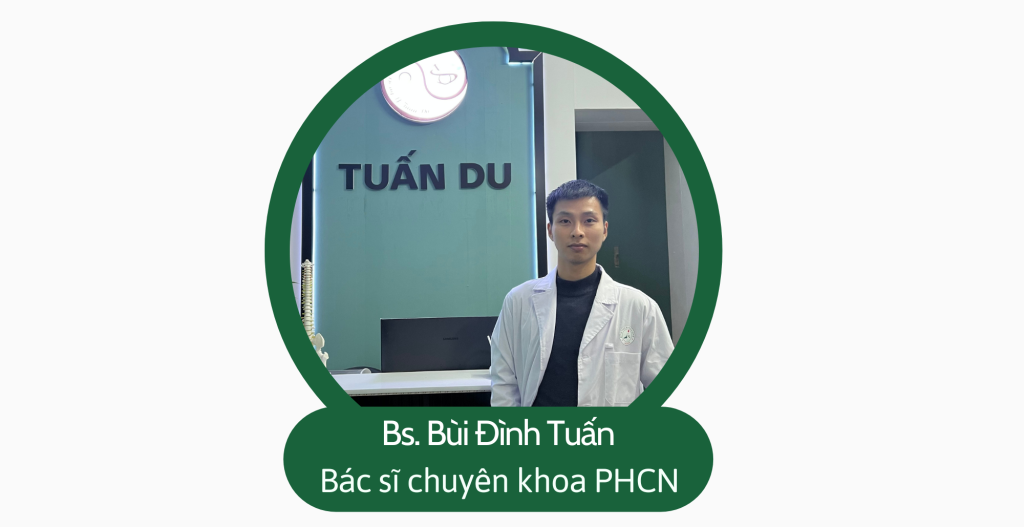A. What is electric pulse current therapy?
Electric pulse current is a method of using low- and medium-frequency pulsed electrical currents to electrically stimulate nerves through the skin. Effective:
- Pain relief.
- Neuromuscular stimulation causes muscle contraction.
- Electrolysis, electrophoresis of drugs.
Other pain treatment methods at Tuan Du:
Nội dung bài viết
B. BIOLOGICAL EFFECTS OF ELECTRIC PULSED CURRENT
1. The body’s response to electric pulsed current
- Threshold intensity: is the pulse current intensity that reaches a certain value that causes the organization to begin to respond.
- Sensory threshold: is the electric pulse current intensity at which the patient begins to feel an electric current (like tingling, pins and needles…).
- Vibration threshold: is the electric pulse current intensity at which the patient begins to feel the muscle vibrate (due to many muscle fibers contracting).
- Muscle contraction threshold : is the electric pulse current intensity at which the patient begins to contract the muscle, feeling the muscle tightening.
- Pain threshold: is the intensity of the electric pulse current at which the patient feels pain.
- Treatment effective area: is the intensity above the sensory threshold, below the pain threshold.
2. Biological effects of electric pulsed current
2.1. Impact on the body:
Electric pulsed current acting on the body causes two effects: stimulation causes excitement and inhibition reduces nerve excitement.
+ Exciting electric pulse current has the following properties: f < 50Hz, pulse has very steep slope, short pulse duration (sharp, rectangular pulse).
+ Inhibited electric pulse current has the following properties: f > 80Hz, gentle pulse slope, long pulse duration (ploughshare pulse, sinusoidal pulse).
- Motor nerve: responds to current with a maximum frequency of 1,000Hz. If it is greater than 1,000Hz, it no longer responds. For muscles, the maximum frequency of current for the muscle to respond is 200 – 250Hz, larger than the muscle that does not respond. With f < 20Hz, it causes muscle contractions one at a time, frequencies from 20 – 50Hz cause continuous muscle contractions , Frequencies from 50 – 200Hz cause sawtooth muscle contractions , while above 200Hz, muscle contractions gradually weaken, and at 250Hz, muscle contractions no longer occur .
- Sensory nerves: respond to frequencies from 0 – 1,000Hz. With frequencies from 0 – 20Hz, each pulse feels like an object touching the skin, at frequencies of 20 – 50Hz there is a feeling of continuous vibration on the skin surface, f > 100Hz the vibration feeling gradually weakens until 1,000Hz there is no longer a feeling. .
- Autonomic nerve: frequency < 20Hz will cause sympathetic nerve stimulation, frequency 20 – 50Hz will cause parasympathetic nerve excitement, frequency > 100Hz will cause sympathetic nerve inhibition.
Frequency > 1,000Hz, the electric pulsed current no longer stimulates the nerve. With medium frequency electric pulsed currents, to be effective, the pulse amplitude must be changed to create a pulse with a low frequency below 1,000Hz. The therapeutic effect is caused by the capsular pulse, because the capsular pulse is formed in the tissue, so it does not irritate the skin and will avoid burning pain for the patient.
2.2. Pain relief theory of electrical impulses
There are three theories about the analgesic effect of pulsed electric current:
+ CONTROL GATE THEORY
This theory was proposed by Melzack and Wall (1965) based on the structure and function of sensory nerve pathways:
- Small fibers (Ad and C) transmit pain sensations , before contacting T cells in the spinal cord, these fibers give a branch to contact with associated neurons. Stimulation from small fibers causes inhibition of association neurons. When the association neuron is inhibited, there is no pre-synaptic inhibitory signal, at this time the “gate” opens and pain impulses are transmitted to the thalamus.
- Large fibers (Aa, Ab) mainly transmit somatic sensations, and also transmit pain sensations but only with appropriate stimuli. Large fibers also have branches that contact associated neurons before contacting cells. T cells. Impulses from large fibers excite association neurons. The excited association neurons will inhibit the presynaptic transmission of both large and small fibers, causing the “gate” to close, and the impulse cannot be transmitted to the thalamus.
- Pulse currents with f < 50Hz, vertical pulse slope and narrow pulse width, nerve stimulation is transmitted mainly along small fibers, causing synaptic neurons to be inhibited without causing presynaptic inhibition, leading to “open gates”, impulses. movement up the thalamus causes pain. With a frequency > 80Hz, a gentle pulse slope, and a large pulse width, nerve stimulation is transmitted mainly along large fibers, the associated neurons are excited, causing the “gate” to close, causing pain relief.
+ THEORY OF ENDORPHIN RELEASE
This theory proposed by Sjoloud and Eriksson suggests that in cases of chronic pain, it may be due to reduced activity of the endorphin system or increased destruction of endorphins in nerve tissue. The central nervous system under the effect of electric pulsed current will increase the release of endorphins. Endorphin as an endogenous morphine has a strong analgesic effect.
The TENS (high frequency, low intensity) current is thought to stimulate the spinal cord to secrete endorphins (endogenous morphine).
+ THEORY OF POST-STIMULATION STAGNATION OF THE CENTRAL NERVOUS SYSTEM
The theory of post-stimulation stagnation of the central nervous system proposed by Sato and Schmidt states that selective stimulation of group II and III nerve fibers will cause central nervous system inhibition and pain relief.
2.3. Electric pulse current applications:
- To relieve pain, reduce muscle spasms, and increase circulation, choose electric pulsed currents with inhibitory properties. To stimulate muscle contraction (muscle paralysis, paralysis, muscle training) and nerve recovery, choose a electric pulse current that has an excitatory effect.
- Anti-inflammatory: electric pulsed current has anti-inflammatory effects based on enhancing circulation, metabolism, reducing edema, enhancing humoral and cellular immunity, reducing inflammatory substances, only applies to non-inflammatory inflammation. infection.
- Induces sleep: square electric pulsed current with a frequency of 100 – 150Hz, passed through the brain with an electrode on the forehead, an electrode on the nape of the neck has the effect of inducing sleep.
BOOK NOW:
TUẤN DU ORIENTAL HEALTHCARE
Address: No.369 – Nguyễn Trãi street – Hà Giang City
Phone: (+84) 983 444 560 – (+84) 359 736 095






HOT NEWS
Combo Refresh tại Đông Y Tuấn Du: Phục Hồi Năng Lượng Sau Hành Trình Khám Phá Hà Giang
Hà Giang là điểm đến lý tưởng với cảnh sắc hùng [...]
Herbal Shampoo After Massage at Tuấn Du Oriental Healthcare – Feeling Fresh and Clean.1
You’ve just finished an incredibly relaxing massage session, and your whole [...]
Gội Đầu Thảo Dược Sau Massage – Đã “Đã” Rồi Lại Còn “Sạch Sành Sanh”!
Bạn vừa hoàn thành buổi massage thư giãn cực đã, toàn [...]
Cặp Thuốc Bổ Thận Bổ Dương Hoàng Kỳ và Phụ Tử: Bí Quyết Tăng Cường Sức Khỏe Nam Giới 2024
Trong hệ thống y học cổ truyền, hoàng kỳ và phụ [...]
Cặp thuốc táo thấp hóa đàm hay được sử dụng trong đông y
Bán Hạ Và Sinh Khương – Cặp Thuốc Táo Thấp Hóa [...]
Hiệu Quả Tiêu Thực Của Thần Khúc Và Mạch Nha Trong Đông Y
Thần Khúc Và Mạch Nha – Cặp Thuốc Tiêu Thực Hiệu [...]